Before open floor plans and stainless steel appliances dominated home design magazines, kitchens had a distinctive character filled with items that defined an era. These weren’t just cooking spaces—they were the heart of the home where family recipes were passed down, morning coffee rituals unfolded, and late-night conversations happened over leftover pie. While today’s kitchens might boast smart refrigerators and coffee makers controlled by smartphones, there’s something undeniably charming about the functional, familiar items that once populated every cooking space in America.
1. The Avocado Green or Harvest Gold Appliances
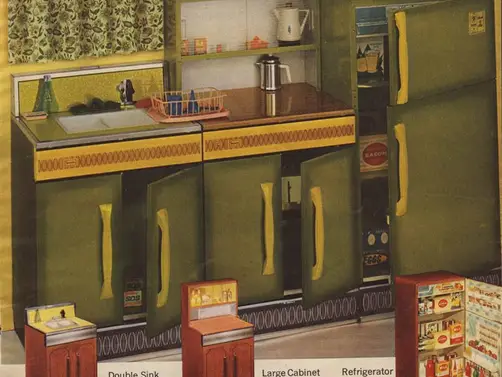
Nothing dates a kitchen more precisely than the distinctive color palette that dominated appliances from the late 1960s through the 1970s. These boldly colored refrigerators, stoves, and dishwashers transformed kitchens from utilitarian workspaces into fashion statements that coordinated with equally colorful countertops and backsplashes. Homeowners committed to these substantial investments despite their significant cost, creating kitchens where avocado green refrigerators hummed alongside matching stoves and dishwashers in a symphony of coordinated color. Relics in Situ considers these two colors as the shades of the ’70s.
The colors became so ubiquitous that they expanded beyond appliances to encompass everything from toasters and blenders to fondue pots and electric can openers. These appliances proved remarkably durable, with many households maintaining their colorful kitchens well into the 1990s out of either appreciation for quality craftsmanship or budget constraints that delayed updates. Today, these once-maligned colors have experienced a nostalgic renaissance, with vintage appliance collectors and retro enthusiasts paying premium prices for the very same avocado green refrigerators that children once found embarrassingly outdated.
2. A Well-Worn Set of Tupperware
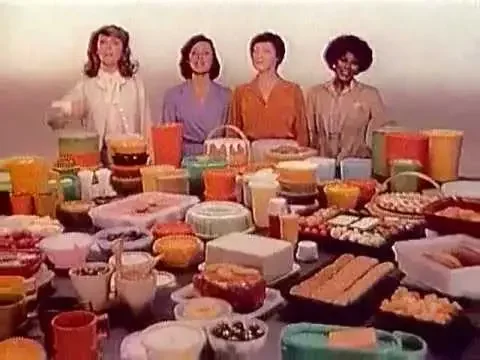
These colorful plastic containers revolutionized food storage with their patented “burping” seal that promised freshness far beyond previous options. The distinctive pastel colors—mint green, powder blue, sunshine yellow, and peachy pink—created cheerful refrigerator interiors as leftovers found their perfect-sized homes. Tupperware represented more than mere storage; it symbolized domestic efficiency, waste reduction, and the modern homemaker’s commitment to family nutrition and budget-conscious meal planning. HowStuffWorks dives into the history of Tupperware in a way that puts into perspective just how popular and mainstream these used to be.
The Tupperware party became a social institution, bringing neighbors together for demonstrations that combined entertainment with practical purchasing. Opening the cabinet dedicated to plastic storage meant facing an avalanche of containers and an archaeological dig for matching lids that invariably outnumbered their containers or disappeared entirely. The durability of these products meant many families still use pieces inherited from mothers and grandmothers, with vintage Tupperware commanding surprising prices from collectors seeking authentic mid-century kitchen artifacts.
3. A Copper Jell-O Mold Hanging on the Wall
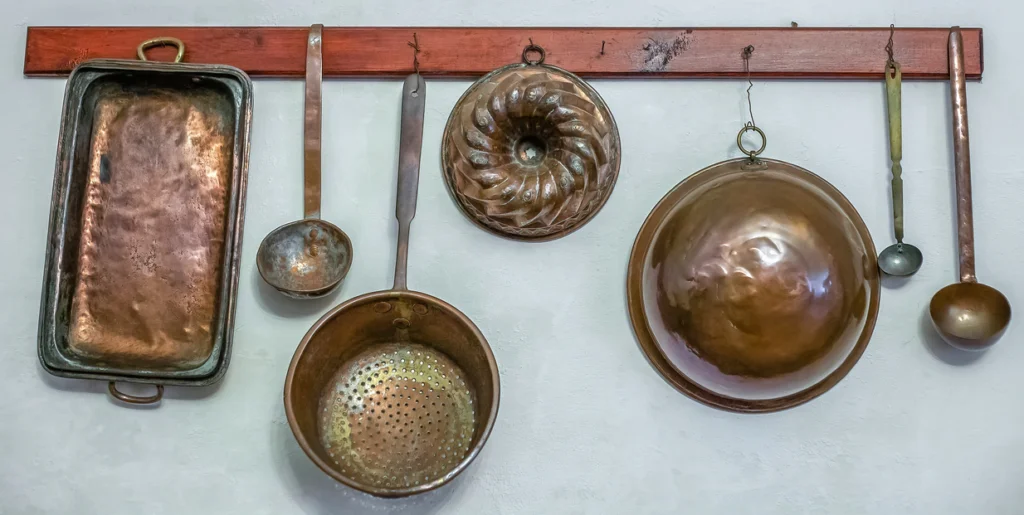
These decorative copper molds served dual purposes as wall art and practical cooking implements for the gelatin salads and desserts that graced every potluck and holiday table. Their intricate designs—pineapples, fluted rounds, or bundt shapes—created eye-catching dimensional interest on kitchen walls otherwise dominated by wallpaper or paint. Using these molds required serious culinary timing and unmolding skills, with success measured by how perfectly the elaborate shape translated to the finished gelatin creation. LoveToKnow delves into the deeper history of copper molds, which actually date back centuries.
The most dedicated home cooks displayed extensive collections, creating impressive gallery walls of gleaming copper that announced their dessert-making capabilities to all visitors. These molds represented hospitality traditions where molded salads containing suspended fruit, vegetables, or marshmallows demonstrated both creativity and adherence to established culinary conventions. While rarely used in contemporary cooking, these copper molds continue adorning walls in vintage-inspired kitchens, connecting modern spaces to culinary traditions that valued presentation as highly as flavor.
4. A Calendar from the Local Funeral Home

These free promotional calendars featured inspirational scenes, adorable puppies, or peaceful landscapes above monthly grids filled with handwritten appointments, birthdays, and reminders. The local funeral home, insurance agency, or bank distributed these practical marketing tools each December, ensuring their contact information remained visible throughout the entire year. The kitchen calendar served as the family’s analog organization system, with multiple handwritings documenting dental appointments, school events, and work schedules in a centralized location everyone could reference.
Turning the page at the beginning of each month became a small ceremony of time passing and upcoming events, with important dates immediately transferred to maintain continuity. The densely noted squares created a visual diary of family life, with grocery lists, phone messages, and reminder notes often tucked behind pages for future reference. These utilitarian calendars have largely been replaced by digital alternatives, though many households maintain the tradition of a central paper calendar despite smartphone capabilities, recognizing the value of visible scheduling that doesn’t require device access.
5. A Ceramic Cookie Jar in Novelty Shape
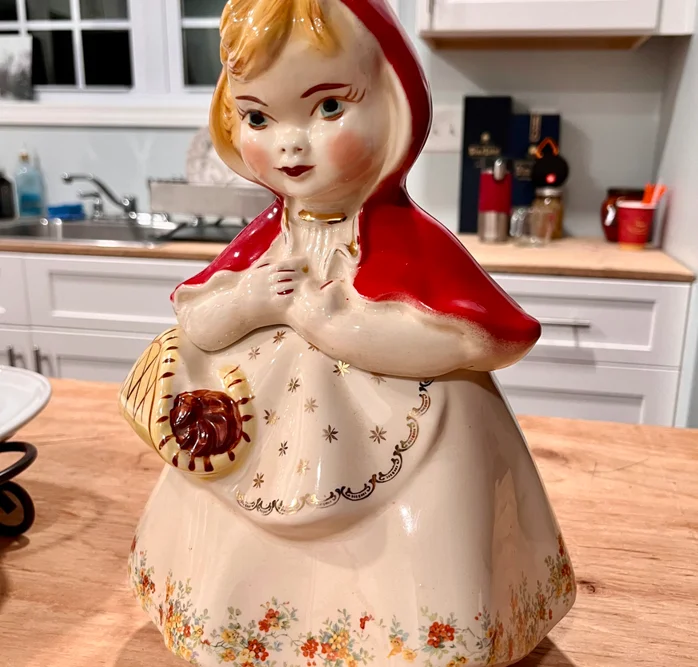
These countertop staples—shaped like cheerful animals, cartoon characters, or stylized houses—promised freshly baked treats while adding personality to the kitchen landscape. The distinctive sound of the heavy lid being replaced after cookie selection alerted mothers to unauthorized snacking between meals. Cookie jars transcended mere storage, becoming family heirlooms that carried emotional connections to childhood memories of after-school treats and special occasion baking.
Collecting distinctive cookie jars became a hobby for many homemakers, with specific shapes or manufacturers commanding dedicated shelf space and occasional rotation into active duty. The most beloved jars featured chips and wear patterns that mapped decades of hands reaching inside for homemade chocolate chip cookies, store-bought sandwich cookies, or occasional non-cookie treasures. Contemporary kitchens may have sacrificed these charming containers for sleeker storage options, but vintage cookie jars now command impressive prices from collectors seeking to recapture childhood memories one ceramic animal at a time.
6. A Spice Rack with Matching Jars
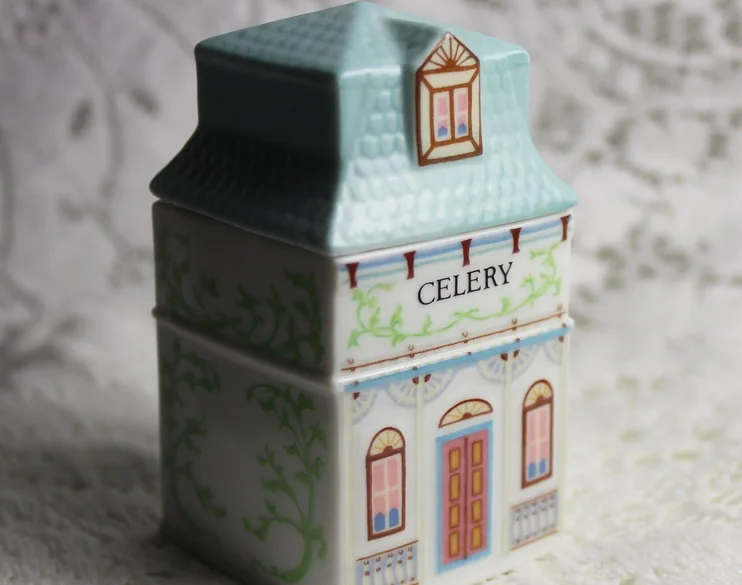
Organized alphabetically or by frequency of use, these matching spice containers announced the home cook’s commitment to flavorful cooking and kitchen organization. The standard arrangement featured small glass jars with cork or plastic lids arranged on tiered wooden shelves that maximized visibility while minimizing counter space. Many households received these as wedding gifts, with the filled jars representing an investment in properly seasoned meals for the newly established home.
The contents often aged well beyond recommended freshness dates, with some rarely-used spices achieving archaeological significance before replacement. Annual kitchen cleaning sometimes revealed surprising discoveries—spices purchased for single recipes, mysterious unlabeled mixtures, or duplicate purchases made when the original jar couldn’t be located in the moment. The matching uniformity of these racks brought visual order to the diversity of colorful powders and dried herbs contained within, satisfying the organizational instinct while keeping cooking essentials within easy reach.
7. A Metal Canister Set for Flour, Sugar, Coffee, and Tea
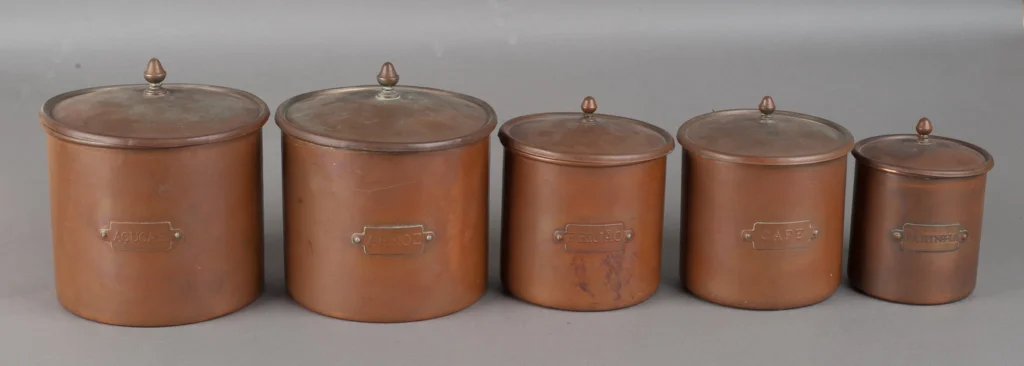
These matching containers—typically arranged by size from largest to smallest—kept staple ingredients organized while adding decorative elements to valuable counter space. The sets came in materials and designs that reflected kitchen decor trends, including ceramic, aluminum, copper-accented, or plastic with folk art designs or roosters. Proper canister use required a delicate transfer process from original packaging, with spills of flour or sugar creating momentary kitchen crises that required immediate cleanup.
The largest canister typically held five pounds of flour for frequent bakers, while the smallest might contain tea bags or restaurant sugar packets collected for home use. Children learned important kitchen lessons by being entrusted with carefully measuring ingredients from these containers under supervision, gradually earning the right to access their contents independently. These practical storage solutions created visual continuity in kitchens otherwise filled with mismatched appliances and cookware collected over decades of homemaking.
8. A Drawer Overflowing with Plastic Bags

Long before environmental concerns limited single-use plastics, kitchens contained dedicated storage for carefully folded grocery bags awaiting their second lives. These bags served countless secondary purposes—garbage bin liners, wet swimsuit transporters, lunch containers, and temporary gloves for particularly messy kitchen tasks. The collection system often involved stuffing bags inside one designated bag hung on a doorknob, creating an ever-expanding storage solution that occasionally required culling when the collection threatened to escape its boundaries.
The most organized households featured bags flattened and folded into neat triangles or squares, while others embraced the crumpled approach that maximized storage capacity at the expense of orderliness. Children learned early that bringing home school projects in these repurposed carriers signaled frugality rather than forgetfulness about proper school supplies. These practical storage habits formed during Depression-era childhoods or war rationing continued long after economic necessity, creating generations who still feel uncomfortable discarding potentially useful packaging.
9. A Coffee Percolator That Announced Breakfast
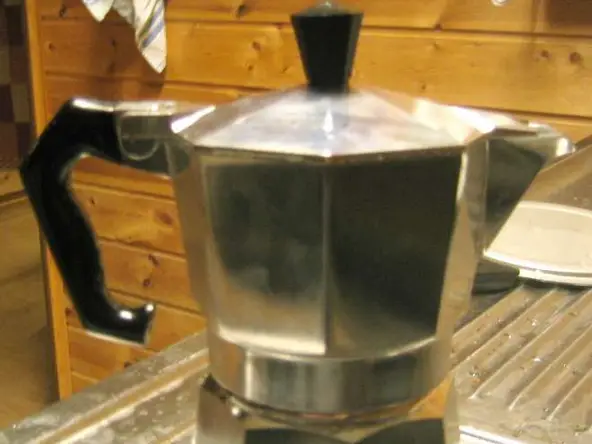
Before programmable brewers and pod systems, the familiar gurgling sound of percolating coffee created a sensory alarm clock that announced morning had officially begun. These stovetop or electric brewers featured clear glass knobs that allowed visual monitoring of the coffee’s deepening color during the brewing cycle. The distinctive sounds, smells, and occasional overflows created coffee-making routines filled with sensory memories that modern brewing methods cannot replicate.
Proper percolator use required judgment about water-to-grounds ratios, brewing time, and heat settings that transformed coffee-making into a skill rather than a button-pushing exercise. Many households maintained dedicated percolators for everyday use and special occasions, with company coffee meriting the electric version that kept beverages warm throughout leisurely visits. The percolator’s coffee—stronger and sometimes more bitter than contemporary brewing methods—fueled generations of Americans through morning routines and after-dinner conversations before being gradually replaced by drip coffee makers promising greater convenience and consistent results.
10. A Well-Used Recipe Box Filled with Index Cards
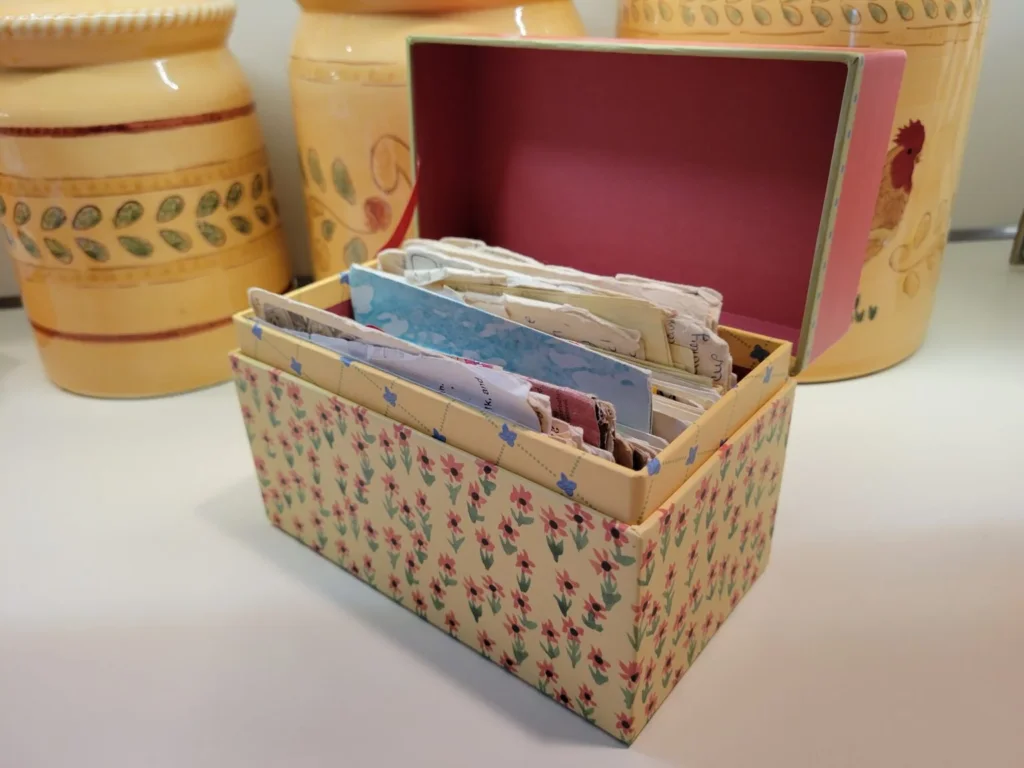
These treasure chests of family culinary history contained handwritten recipe cards, newspaper clippings, and instructions jotted on whatever paper had been available when someone requested a recipe copy. The most cherished recipes bore evidence of their popularity—food stains, multiple handwritings adding notes or variations, and sometimes several versions representing the evolution of family favorites. Recipe boxes connected generations through shared tastes, with grandmothers’ handwriting preserving traditional techniques alongside daughters’ adaptations that incorporated modern ingredients or simplified preparation methods.
Categories separated by divider cards created organization systems ranging from traditionally labeled sections like “Desserts” and “Main Dishes” to more personalized classifications like “Christmas Only” or “Frank’s Favorites.” These boxes documented more than mere cooking instructions; they mapped family celebrations, regional influences, friendship connections, and the gradual incorporation of international cuisines into American home cooking. Contemporary cooks may search online for dinner inspiration, but many still treasure these handwritten repositories of family food traditions that captured personal notations impossible to replicate in digital formats.
11. A Kitchen Timer That Actually Ticked
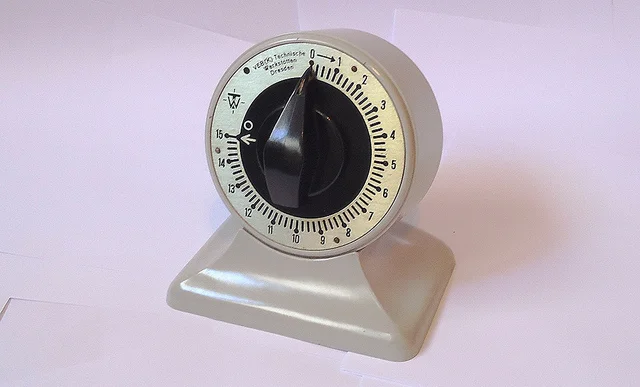
Before smartphones offered multiple timing functions, mechanical kitchen timers with their audible ticking and satisfying ring announced when foods had reached perfect doneness. The most common version resembled a small clock face where turning the dial fully and then back to the desired time activated the countdown mechanism. The steady ticking created a reassuring kitchen soundtrack that signaled active cooking was underway, while the final ring could be heard throughout the house.
Children often received kitchen timer responsibility as their first cooking task, watching the dial and alerting adults when baking or boiling times concluded. These simple devices required no batteries, programming, or technical expertise—just a twist of the dial and basic number recognition to ensure cookies didn’t burn. Even households with digital appliances often maintained traditional timers as backup systems, recognizing the reliability of mechanical devices that continued functioning through power outages and battery failures.
12. A Magnetic Notepad for Grocery Lists

Usually featuring cheerful designs and the words “To Market, To Market” or “Don’t Forget,” these small notepads stuck to refrigerator doors provided centralized grocery tracking for the entire household. Family members added items throughout the week as supplies dwindled, creating collaborative shopping lists that prevented return trips for forgotten essentials. The small pencil or pen often attached by string frequently disappeared despite ingenious securing methods, leading to notes written in multiple implements ranging from crayons to eyeliner pencils.
The systematic shopper tore off completed lists, while more spontaneous types simply crossed off items and continued using increasingly messy pages until the pad required replacement. These humble notepads documented changing family preferences, dietary trends, and seasonal cooking patterns through their itemized requests for specific brands and ingredients. Modern digital list-sharing can’t replicate the satisfaction of physically crossing completed items off paper lists or the archaeological record of family food preferences preserved in these simple pads.
13. A Kitchen Table That Witnessed Everything
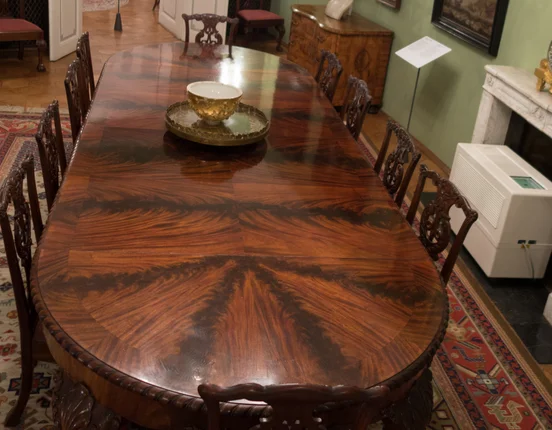
Before dining rooms became standard and islands with barstools replaced traditional eating spaces, the kitchen table served as the true center of family life. These sturdy pieces—often featuring heat-resistant laminate tops and chrome legs—witnessed homework sessions, bill paying, heart-to-heart conversations, and countless meals that fueled family life. The comfortable familiarity of assigned seating created an unspoken choreography as family members automatically gravitated to their usual chairs for each gathering.
Kitchen tables expanded their functional roles throughout the day—from breakfast station to mail sorting surface to homework headquarters to dinner gathering place. The table’s central role in family life made kitchen placement essential, with layouts designed to accommodate this furniture even at the expense of additional cabinets or work surfaces. While contemporary homes often feature breakfast nooks, dining rooms, and kitchen islands that fragment eating spaces, the simple kitchen table remains an iconic symbol of family togetherness and practical functionality that newer designs struggle to replicate.
These kitchen staples did more than just fill space—they created the backdrop for family stories, holiday traditions, and everyday moments that shaped generations of Americans. While contemporary kitchens might showcase cleaner lines and more technological integration, there’s something undeniably special about these functional, familiar items that once defined the heart of the home. Perhaps that explains why so many of these vintage pieces now command premium prices from collectors seeking to recapture not just the look of yesterday’s kitchens, but the warm, practical spirit they embodied.


